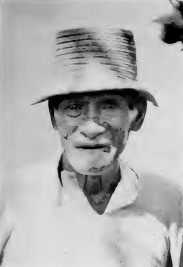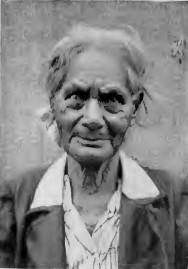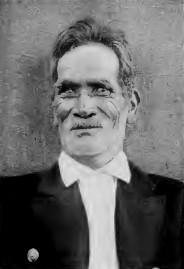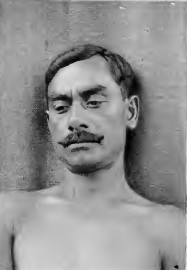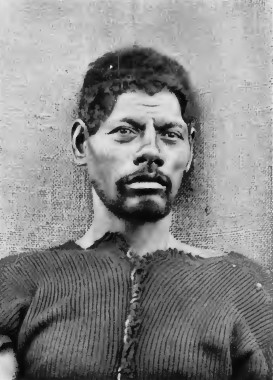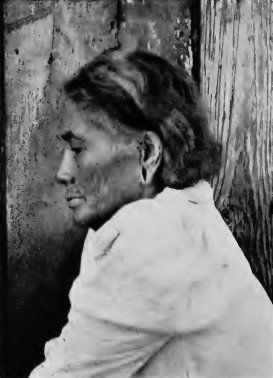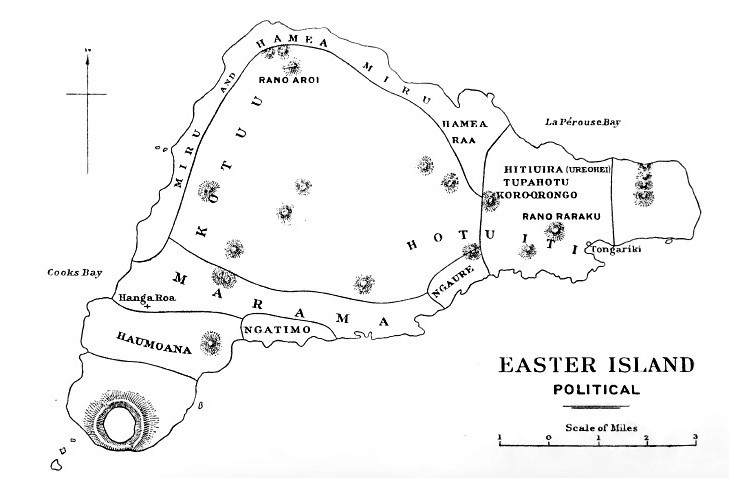| Web
and Book design,
Copyright, Kellscraft Studio 1999-2015 (Return to Web Text-ures) |
 (HOME)
|
|
CHAPTER
XV
NATIVE CULTURE IN PRE-CHRISTIAN TIMES Sources of Information: History, Recent Remains, Living Memory — Mode of Life: Habitations, Food, Dress and Ornament — Social Life: Divisions, Wars, Marriages, Burial Customs, Social Functions. It has
been seen that any knowledge which exists on the island with regard to
the
origin of the monuments is of the most vague description, and it is
therefore
necessary, in the attempt to solve the problem, to rely principally on
indirect
evidence. It becomes in particular essential to collect all possible
information about the present people; not only for its intrinsic
anthropological
interest, but in order to find if any links connect them with the great
builders, or if we must look for an earlier race. As a
first step in the search the scientist naturally turns to the most
ancient
accounts which he can find describing the island, its inhabitants, and
remains;
these are not yet two hundred years old. The first European to see it
was a
Dutch Admiral named Roggeveen, who came upon it on Easter Day, 1722,
during his
search for another and mysterious island known as Davis or David's
Island.1
He concluded that it was not the place for which he was looking,
christened it
Easter Island, and went further afield. His ship lay off the north side
of the
island for a week, but only on one day did landing take place, and one
or two
of the party have left us short descriptions. There were, they say, no
big
trees, but it had a rich soil and good climate; there were sugar-cane,
bananas,
potatoes and figs, and the natives brought them a number of fowls,
estimated
varyingly from sixty to five hundred. One of the voyagers goes so far
as to say
that "all the country was under cultivation." As for the inhabitants,
they were, they tell us, of all shades of colour, yellow, white, and
brown, and
wore clothes made of a "field product," evidently tapa. They were
"painted," which apparently signifies tattooed, and it was the habit
to distend the lobes of their ears so that they hung to the shoulders,
and
large discs were worn in them. “When these Indians," wrote Roggeveen,
"go about any job which might set their ear-plugs wagging, and bid fair
to
do them any hurt, they take them out and hitch the rim of the lobe up
over the
top of the ear, which gives them a quaint and laughable appearance." 2
The
natives were extraordinarily thievish, stealing the caps from the
seamen's
heads, while one actually climbed into the port-hole of the cabin and
took the
cloth off the table. These habits gave rise to an unfortunate incident,
as when
the visitors came on shore, a scuffle took place over the sanctity of
property,
and the natives began throwing stones, on which a petty official gave
the order
to fire, ten or twelve natives being killed. The occurrence, however,
was duly
explained, and did not terminate amicable relations. We learn that at
this time
the great statues, of which this is of course the first report, were
then, as
has already been noted, standing and in place. The Dutchmen describe
them as
"remarkable, tall, stone figures, a good 30 feet in height," and
notice that they have crowns on their heads; a clear space was, they
said,
reserved round them by laying stones. They have no doubt that the
figures are
objects of worship; the natives "kindle fires in front of them, and
thereafter squatting on their heels with heads bowed down, they bring
the palms
of their hands together and alternately raise and lower them." Another
observer adds, in connection with this worship, that they "prostrated
themselves towards the rising sun." A great step would have been gained
towards the solution of the problem if we could feel assured that these
last
remarks were justified and were not merely the result of imperfect
observation. 3 For fifty
years darkness once more descends on the history of the island. Then,
within a
period of sixteen years, it was visited by three expeditions, Spanish,
English,
and French respectively. The Spanish were under the command of Gonzalez.4
They too were searching for David's Island when, in 1770, they touched
at
Easter, and they also came to the conclusion that it was not their
goal. They
took, however, formal possession of it, and named it San Carlos. Their
ships
lay at anchor in the same place as had those of Roggeveen, the bay on
the north
coast now called after La Pérouse. From this anchorage three curious
hillocks
on the northern slope of the great eastern volcano form striking
objects (fig.
78); on each of these they planted a cross, and proclaimed the King of
Spain
with banners flying, beating of drums, and artillery salutes. The
natives
appear to have thoroughly enjoyed the proceedings, and "confirmed
them," according to the solemn statements of the Spaniards, by marking
the
official document with their own script. This is the first that we hear
of a
form of native writing. The expedition sent a boat round the island,
which made
a very creditable map of it. Four
years later Cook cast anchor on the west side in the bay which is known
by his
name. He was there three days and did not himself explore inland, but
his
officers did so, including the elder Forster, the botanist of the
expedition,
and his account of what they saw was published by his son.5 In 1780
La Pérouse anchored in the same place, and also sent some of his men
inland,
who covered partly, but not entirely, the same districts as those of
Cook.6 As these
expeditions were so nearly of the same date, their remarks may fairly
be
compared and contrasted with those made by Roggeveen half a century
earlier.
All three give very similar descriptions of the people, their
appearance and
dwellings, which also resemble the accounts of the Dutch. Cook is very
much
impressed with the long ears, though La Pérouse does not refer to them.
There
is the same story of the native powers of appropriating the goods of
the strangers.
Cook says that they were "as expert thieves as any we had yet met
with," and Pérouse, whose own hat they stole while helping him down one
of
the image platforms, is particularly aggrieved at such conduct,
considering
that he has given them sheep, goats, pigs, and other valuable presents;
peace
was only kept between the crew and the natives by official compensation
being
given the seamen for their lost property. Here,
however, the resemblance of these accounts with that of Roggeveen ends.
The
descriptions which are given by these later expeditions of the state of
the
country, and its facilities as a port of call, are very different from
those of
the Dutchmen. The Spaniards speak of it as being uncultivated save for
some
small plots of ground. The Englishmen are the reverse of enthusiastic.
Forster
calls it a "poor land," and Cook says that "no nation need
contend for the honour of the discovery of this island, as there can be
few
places which afford less convenience for shipping." "Poultry"
now consists of only a "few tame fowls" — later still we find that
only one is produced. Pérouse, although he is not so depressed as Cook,
tells
us that only one-tenth of the land is cultivated. With regard to the
population
Roggeveen gives no number, and probably was not in a position to do so.
The
estimates made by the Spanish and English are very similar. Gonzalez
puts it at
nine hundred to one thousand, Cook at seven hundred; both of them,
however,
state that the number of women seen seemed to be disproportionately
small. La Pérouse,
writing of course some years later, speaks of the number as two
thousand and
has seen many women and children. Both English and French are
interested to
find that the language is similar to that spoken elsewhere in the
Pacific. Again, in
dealing with the state of the monuments and the way in which they were
regarded, the impressions of the later observers differ greatly from
those of
Roggeveen. The Spaniards do not tell us very much. They saw from the
sea what
they thought were bushes symmetrically put up on the beach, and dotted
about
inland; later they found that they were in reality statues, and they
wondered
particularly how their crowns, which they observed were of a different
material, were raised into place. It was one of the Spanish officers
who
states, as recorded at the beginning of this book, that the seashore
was lined
with stone idols,7 from which it may be gathered
that the great
majority were still erect. The figures were, they tell us, all set up
on small
stones, and burying-places were in front. It is interesting, in view of
what we
know of the prohibition of smoke near the ahu,8
to find one of the
Spanish writing: "They could not bear us to smoke cigars; they begged
our
sailors to extinguish them, and they did so. I asked one of them the
reason,
and he made signs that the smoke went upwards; but I do not know what
this
meant."9 Cook's people observed that the natives
disliked these
burying-places being walked over, but whereas Roggeveen was convinced,
whether
rightly or wrongly, that the cult of the statues was what we should
call "a
going concern," Cook, fifty years later, is equally certain that it is
a
thing of the past; some of the figures are still standing, but some are
fallen
down, and the inhabitants "do not even trouble to repair the
foundations
of those which are going to decay." "The giant statues," he says,
“are not in my opinion looked upon as idols by the present inhabitants,
whatever they may have been in the days of the Dutch." Forster also
remarks that "they are so disproportionate to the strength of the
nation,
it is most reasonable to look upon them as the remains of better
times."
La Pérouse does not agree with this last sentiment; he admits that at
present
the monuments are not respected, but he sees no reason why they should
not
still be made even under existing conditions; he thinks that a hundred
people
would be sufficient to put one of the statues in place. The objection
he sees
is that the people have no chief great enough to secure such a
memorial. It is
unfortunate that the mountain of Rano Raraku is so far removed from
both the north
and west anchorages, that none of the voyagers discovered it, although
Cook's
men were very near that from which the crowns were obtained. 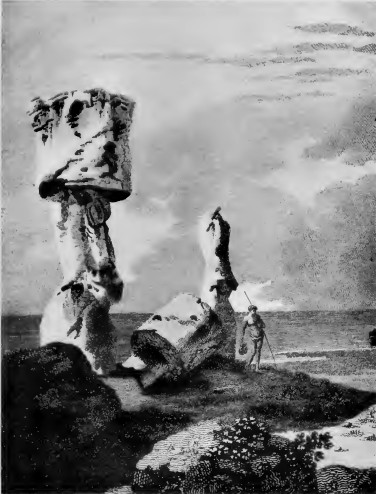 [Drawn from Nature by W . Hodges.] FIG. 82. — MONUMENTS IN EASTER ISLAND. From A Voyage To-d'ards the South Pole, James Cook, 1777, vol. i., part of pi. xlix. The
artist has not observed the features or arms of the images, nor that
they stand
on stone platforms. The hats, as shown, greatly exceed their true
proportion to
the figures. The picture has probably been redrawn from memory. In the
nineteenth century we have a few accounts from passing voyagers.
Lisiansky, in
1804, found no people with long ears,10 but in
1825 Beechey in
H.M.S. Blossom says that there were
still a few to be seen. With regard to the statues, the process of
demolition
has gone so far that Beechey declares "the existence of any busts is
doubtful."11 It
is
amusing to find, a hundred years after Roggeveen's similar experience,
that the
Blossom has an affray with natives over the stealing of caps. While
attention
has been drawn to the importance of these early narratives, it must be
remembered that all the visits were of very short duration, and that
the old
voyagers were not trained observers. The Dutchmen, for instance,
deliberately
tell us that the statues have no arms. The accounts frequently give the
impression of being written up afterwards from somewhat vague
recollection, and
in most cases the narrators have read those of their predecessors and
go
prepared to see certain things. One navigator who never landed assures
us that
the houses are the same as in the days of La Pe rouse. On the other
hand, with
regard to the stores available, they are, so to speak, on their own
quarter-deck, and their remarks can be accepted without question. In the
"sixties" of last century the great series of changes took place
which brought Easter Island into touch with the modern world. The first
of
these largely broke those chains with the past which the archaeologist
now
seeks to reconstruct. Labour was needed by the exploiters of the
Peruvian guano
fields, and an attempt which was made to introduce it from China having
failed,
slave-raids were organised in the South Sea Islands. As early as 1805
Easter
had suffered similarly at the hands of American sealers, and it was
amongst the
principal islands to be laid under contribution in December 1862. It is
pathetic even now to hear the old men describe the scenes which they
witnessed
in their youth, illustrating by action how the raiders threw down on
the ground
gifts which they thought likely to attract the inhabitants, and, when
the
islanders were on their knees scrambling for them, tied their hands
behind
their backs and carried them off to the waiting ship. The natives say
that one
thousand in all were so removed from the island, and, unfortunately,
there were
amongst them some of the principal men, including many of the most
learned, and
the last of the ariki, or chiefs. Representations were made by the
French
Minister at Lima, and a certain number were put on board ship to be
returned to
their home. Smallpox, however, had been contracted by them, and out of
one
hundred who were to be repatriated, only fifteen survived. These, on
their
return to the island, brought the disease with them, which spread
rapidly with
most fatal results to the population. Meantime,
shortly before the raid, the attention of the Roman Catholic
"Congregation
of the Sacred Heart of Jesus and Mary” in Valparaiso had been drawn to
the
island by the account received from a passing ship, and they determined
to
inaugurate a mission. Three of the Community left for Easter Island,
their
route taking them by way of Tahiti. Finally, only one continued, Eugene
Eyraud,
who landed on the island in January 1864. Eyraud was a lay brother in
the Order,
having been a merchant in South America; he devoted his life to the
call to
take the Gospel to Easter, and the accounts of his work, which are
extraordinarily interesting, leave a great impression of his courage
and
devotion.12 He was alone on the island for eight
or nine months, and
was at the mercy of the natives, who stole his belongings, even to the
clothes
he was wearing, and compelled him to make a boat for them. In March
1866,
Eyraud, after a visit to Chile, returned with another missionary,
Father Roussel,
and the two were for a while blockaded in a house which they had put
up, but
the tide now turned. Either Roussel was a man of greater determination
than
Eyraud, or with increased numbers a firmer attitude was possible.
Surgeon
Palmer of H.M.S. Topaze tells us
that
when one of the natives took up a stone with a menacing gesture,
Roussel
quietly felled him with his stick and went on his way, after which
there was no
further trouble. The missionaries were joined later in the year by two
more of
their number, and became a power in the land. Eyraud on
his return from Chile was suffering from phthisis, of which he died in
August
1868. When he was nearing his end he asked Roussel if there still
remained any
heathen in the island, to which the Father replied "not one"; the
last seven had been baptized on the Feast of the Assumption. It seems
natural
to connect with Eyraud 's illness the fact that there was at the same
time a
severe epidemic of phthisis in the island; so little was the need of
precaution
understood at this date, that even Surgeon Palmer, writing of the
inroads made
by consumption, remarks "which they (the natives) believe
infectious."13 The
ravages of this disease, following on those of smallpox, reduced the
population, which at the time of the arrival of the mission had stood
at twelve
hundred, by about one-fourth. The
remarks of the missionaries on native customs, particularly those
dealing with
their ceremonies, reflect credit on the observers at a time when such
things
were too often thought beneath notice; they will be referred to later.
Their
ethnological work was, however, limited by more pressing exigencies, by
the
difficulties of locomotion on the island, and by the language. Roussel
compiled
a vocabulary, which is useful to students, though not free from the
mode of
thought found in a well-known missionary dictionary, which translates
hansom
cab into the Swahili language. It is a curious fact that so completely
were the
terraces now ruined that the Fathers never allude to the statues, and
seem
scarcely to have realised their existence; but it is through them that
we first
hear of the wooden tablets carved with figures. The body of professors
acquainted with this art of writing perished, either in Peru or by
epidemic,
and this, in connection with the introduction of Christianity, led to
great
destruction of the existing specimens of this most interesting script.
The
natives said that they burnt the tablets in compliance with the orders
of the
missionaries, though such suggestion would hardly be needed in a
country where
wood is scarce; the Fathers, on the contrary, state that it was due to
them
that any were preserved. Some certainly were saved by their means and
through
the interest shown in them by Bishop Jaussen of Tahiti, while two or
three
found their way to museums after the natives became aware of their
value; but
some or all of these existing tablets are merely fragments of the
original. The
natives told us that an expert living on the south coast, whose house
had been
full of such glyphs, abandoned them at the call of the missionaries, on
which a
man named Niari, being of a practical mind, got hold of the discarded
tablets
and made a boat of them wherein he caught much fish. When the "sewing
came
out," he stowed the wood into a cave at an ahu near Hanga Roa, to be
made
later into a new vessel there. Pakarati, an islander now living, found
a piece,
and it was acquired by the U.S.A. ship Mohican. Side by
side with the establishment of the religious power the secular had come
into being.
The master of the ship who had brought the last two missionaries was a
certain
Captain Dutrou Bornier. He had been attracted by the place; and, having
made
financial arrangements with the mercantile house of Brander in Tahiti,
settled
himself on the island and proceeded to exploit it commercially.
Title-deeds
were obtained from the natives in exchange for gifts of woven material.
The
remaining population was gathered together into one settlement at Hanga
Roa,
the native name for the shore of Cook's Bay. This was the state of
things when
H.M.S. Topaze touched in 1868 and
carried off the two statues now at the British Museum. Dutrou
Bornier had at first spoken enthusiastically of the work of the
missionaries;
later, however, the not unknown struggle arose between the religious
and
secular powers. According to the accounts of the missionaries, they
protested
against the actions of Bornier in taking over two hundred natives,
practically
by force, and shipping them to Tahiti to work on the Brander
plantations.
Bornier retaliated by rendering their position impossible, and the
Fathers
ultimately received orders to transfer their labours to the Gambler
islands.
Jaussen tells us that their converts desired to accompany them, and
that almost
the whole population went on board with them. The captain, however,
instigated
by Bornier, refused to carry so many, and one hundred and seventy-five
were
sent back to the shore. This, therefore, “was the whole population" in
1871.
We have not Bornier's account of the quarrel, but there seems to have
been some
justification for the attitude of the missionaries towards him, as five
years
later he was murdered by the natives, and, if current stories are to be
believed, his end was well merited. Subsequently
one of the Branders lived at Mataveri, and Mr. Alexander Salmon, to
whom the
missionaries sold their interests, at Vaihu on the south coast.14
The Salmon family had intermarried with the royal family of Tahiti, and
the new
resident was well aware of the value of antiquities. According to
native
accounts he organised a band to search the caves and hiding-places for
articles
of interest. They also state that he employed skilled natives to
produce wooden
objects connected with their older culture for sale to passing ships.
He spoke
the language of the island, and when the U.S.S. Mohican
arrived in 1886, he was the source of much of the
information which they subsequently published. It is an important but
difficult
matter to know how far the material thus gleaned thirty years ago was
carefully
obtained and reproduced. One or two of the folk-tales are still told
very much
as retailed by Salmon, but he appears to have taken little interest in
the
surviving customs and failed to understand them. The report of the Mohican, made by Paymaster Thomson, has
been the only account of the island in existence with any pretention to
scientific value.15 The Mohican
was there eleven days, and Thomson went rapidly round the island with a
party
from the ship. The amount of ground covered and work done is
remarkable,
although his statements are naturally not free from the errors
inseparable from
such rapid observation. In 1888
the Chilean Government formally took possession. In 1897 M. Merlet, of
Valparaiso, purchased from the representatives of Brander, Bornier, and
Salmon,
their interest in Easter Island, with the exception of a tract of land
containing the village of Hanga Roa, which the Chilean Government
acquired from
the missionaries and retained in the interest of the inhabitants; this
land covers
a far larger space than the natives are able to utilise. The population
is
again increasing, as will have been seen from the fact that during our
visit
they numbered two hundred and fifty. M. Merlet subsequently sold his
holding to
a company, of which he became chairman. Easter
Island has had many names. That given by the Dutchman has become
generally
accepted, but the Spaniards christened it San Carlos, and in some maps
it is
termed "Waihu," a name of a part of the island erroneously understood
as applying to the whole. A native name is Te Pito-te-henua, "henua" means usually
"earth" and "pito"
"navel."16 Thomson says it was ascribed to the
first
comers. Elsewhere in the Pacific "pito" also means "end."
Churchill holds the name signified simply "Land's End," and was
applied to all these angles of the island, which was itself without a
name.17
Rapa-nui (or Great Rapa) is another native name for which various
explanations
are offered. The
island of Rapa, sometimes known as Rapa-iti, lies some two thousand
miles to
the westward. Thomson states that the name Rapa-nui only dates from the
time
when the men kidnapped by the Peruvians were being returned to their
homes. The
Easter Islanders, finding no one knew the name Te Pito-te-henua, and
that some
comrades in distress from the other Rapa managed to make their place of
origin
understood, called their own home Rapa-nui; a story which sounds hardly
probable, but was presumably obtained from Salmon. According
to the report of H.M.S. Topaze, the
Islanders of their day believed that Rapa was their original home.
Others state
the name was given by a visitor from that island. The brief
accounts which have been referred to are all that is known from
external
evidence of the original life of the present people, and but little
hope was
held out to us in England that those fragments could still be
supplemented.
There were found, however, to be still in existence two possible
sources of
information, namely, the memories of old inhabitants, and the actual
traces
which still remain of the life led by the people previous to the
Peruvian raid
and the coming of Christianity. The great ahu which have so far been
described
are only a part, although the most imposing portion, of the stone
remains of
the island. It is fortunate for the student that when civilisation
appeared the
natives were gathered into one settlement, for they left behind them,
sprinkled
over the island, various erections connected with their original
domestic life.
These buildings were certainly being used in recent times, and are
treated from
this point of view, but for all we know they may have been, and very
possibly
were, contemporary with the great works. The study
of the remains on the island, from the greatest to the least, is by no
means so
simple as may hitherto have appeared. Our earliest attempts at
descriptions,
although conscientious, were almost ludicrous in the light of
subsequent
knowledge, and Captain Beechey's error on the subject of "the busts"
is at least comprehensible. Easter, it must be remembered, is a mass of
disintegrating rocks. When in an idle moment the Expedition amused
itself by
inventing an heraldic design for the island, it was universally agreed
that the
main emblem must undoubtedly be a "stone," "and as
supporters," suggested one frivolous member, “two cockroaches
rampant." The most correct representation would be a stone vertical on
a
stone horizontal. Every individual who has lived, even temporarily, in
the
place, has collected stones and put them up according to taste; and
every
succeeding generation, also needing stones, has, as in the instance of
the manager's
wall, found them most readily in ruining or converting the work of
their
predecessors. Even when a building is comparatively intact, the
original design
and purpose can only be grasped by experience, and matters become
distinctly
complicated when the walls of an ahu have been made into a garden
enclosure and
a chicken-house turned into an ossuary. It must be remembered also that
rough
stone buildings bear in themselves no marks of age. The cairns put up
by us to
mark the distances for rifle fire from the camp were indistinguishable
from
those of prehistoric nature made for a very different purpose. The
result is
that the tumble-down remains of yesterday, and the scenes of unknown
antiquity
blend together in a confusing whole in which it is not always easy to
distinguish even the works of nature from those of man. The other
source of information which was open to us was the memory of the old
people. If
but little was known of the great works, it was possible that there
might still
linger knowledge of customs or folk-lore which would throw indirect
light on
origins. This field proved to be astonishingly large, but it was even
more
difficult to collect facts from brains than out of stones. On our
arrival there
were still a few old people who were sufficiently grown up in the
sixties to
recall something of the old life; with the great majority of these,
about a
dozen in number, we gradually got in touch, beginning with those who
worked for
Mr. Edmunds and hearing from them of others. It was momentous work, for
the
eleventh hour was striking, day by day they were dropping off; it was a
matter
of anxious consideration whose testimony should first be recorded for
fear
that, meanwhile, others should be gathered to their fathers, and their
store of
knowledge lost for ever. Against the longer recollection of extreme old
age,
had to be put the fact that the memories of those a little younger were
generally more clear and accurate. The feeling of responsibility from a
scientific point of view was very great . Ten years ago more could have
been
done; ten years hence little or nothing will remain of this source of
knowledge. Most
happily, these authorities were in almost every case willing and ready
to talk,
and our debt to them is great. They came with us, as has been seen, on
our
explorations of the island, but the greater part of the work was done
when we
were living near the village. Some of them took pleasure in coming up
to
Mataveri and talking in the veranda, enjoying still more, no doubt, the
practical outcome of their subsequent visits to Bailey's domain — the
kitchen.
Others were more at ease in their own surroundings, and then we went
down to
the village and discussed old days in their little banana-plots, while
interested neighbours came in to join the fray. Sometimes a man did
better by
himself, but on other occasions to get two or three together stimulated
conversation. Unfortunately, some of the old men who knew most were
confined to
the leper settlement some three miles north of Hanga Roa, and the
infectious
power of leprosy was not a subject which we had got up before leaving
England.
The Captain of the Kildalton feared
lest even the distance of the settlement from the manager's house might
not
suffice to prevent the plague being carried there by insects, and told
a
gruesome tale, within his knowledge, of two white men who had gone for
a visit
to a Pacific island, one of whom on their return to an American port
had been
immediately sent back to a leper colony. But how could one allow the
last
vestige of knowledge in Easter Island to die out without an effort? So
I went,
disinfected my clothes on return, studied, must it be confessed, my
fingers and
toes, and hoped for the best. It would
not be easy for a foreigner to reconstruct English society fifty years
ago,
even from the descriptions of well-educated old men: it is particularly
difficult to arrive at the truth from the untutored mind. Even when the
natives
knew well what they were talking about, they would forget to mention
some part
of the story, which to them was self-evident, but at which the humble
European
could not be expected to guess. The bird story, for example, had for
many
months been wrestled with before it transpired precisely what was meant
by the
"first egg." Deliberate invention was rare, but, when memory was a
little vague, there was a constant tendency to glide from what was
remembered
to what was imagined. Scientific work of this nature really ought to
qualify
for a high position at the bar. The witness had to be heard, and
discreetly
cross-examined without any doubt being thrown on his story, which would
at once
have given offence; then allowed to forget and again re-examined, his
story
being compared with that of others who had been heard meanwhile.
Counsel had
also to be judge and to act as reporter, and at the same time keep the
witness
amused and prevent the interpreter from being bored, or the court would
promptly have broken up. Though great care has been exercised, it must
be
remembered, when a particular account is quoted, as, for example, that
of Te
Haha regarding the annual inspection of the tablets, while it is
believed to
rest on fact, its absolute accuracy cannot be guaranteed. The
language question naturally added to the difficulty. On landing two
courses had
been open, either to go on with Spanish, of which the younger men had a
certain
knowledge, and which was used by Mr. Edmunds, or to try to get some
hold of the
native tongue. The latter plan was decided on, and though at one time
the
difficulties seemed so great that this course was almost regretted, in
the end
it was vindicated. There is, as stated, a vocabulary in French made by
the
missionaries, and also one in Spanish, but there is no grammar of any
kind.
The next
stage, the putting together of sentences, was still more difficult .
How was it
possible to talk in a language which had no verb "to be"? I had, it
is true, a native maid (fig. 29), but, after the simplest phrases had
been
learnt, topics for conversation were difficult to find. We looked
through
illustrated magazines together, but wild beasts, railway trains, and
the
greater part of the pictures of all kinds, conveyed nothing to her. The
plan
was therefore hit on of a tale, after the manner of the Arabian
Nights, dealing with imaginary events on the island; it was
very weird, but served its purpose, though there were initial
difficulties. The
heroine, for instance, was christened "Maria," but "there
were," Parapina said, "three Marias on the island. Which was it?” and
it was long before she grasped, if indeed she ever did so entirely,
that the
lady was imaginary. A certain sequence of events was somehow made
intelligible
to her. She was then induced to repeat the story, while it was taken
down. It
was copied out and next day read again to her for further correction.
Every
word and idea gained was a help in understanding local names and the
native
point of view. Before the end, in addition to using the language for
the
ordinary affairs of life, it was found possible to get simple answers
direct
from the old men, and understand first-hand much of what they said. Any real
success in intercourse was, however, due to the intelligence of one
individual
who was known as Juan Tepano. He was a younger man about forty years of
age, a
full-blooded Kanaka, but had served his time in the Chilean army, and
thus had
seen something of men and manners; he talked a little pidgin English,
which was
a help in the earlier stages, but before the end he and I were able to
understand each other entirely in Kanaka, and he made clear to the old
men
anything I wished to know, and explained their answers to me. It was
interesting to notice how his perception gradually grew of what truth
and accuracy
meant, and he finally assumed the attitude of watch-dog to prevent my
being
imposed on. Happily, it was discovered that he was able to draw, and he
took
great delight in this new-found power, which proved most useful. The
tattoo
designs were obtained, for example, by giving him a large sheet of
paper with
an outline of a man or woman, also a pencil and piece of candle; these
he took
down to the village, gathered the old men together in their huts in the
evening, and brought up in the morning the figure adorned by the
direction of
the ancients (fig. 88). He took a real interest in the work, learning
through
the conversations much about the place which was new to him, and at the
end of
the time triumphantly stated, “Mam-ma now knows everything there is to
know
about the island." It is
proposed to unite the information gained from locality and memory,
referring
where necessary to the accounts of the early voyagers, and give as
complete
descriptions as possible of the primitive existence which continued on
Easter
Island till the middle of last century. It will be seen that the
condition of
the people on the coming of Christianity, as we were able to ascertain
it,
corresponded almost exactly with that described by the first visitors
from
Europe, more than a hundred years earlier. Such traditions as linger
regarding
the megalithic remains have already been alluded to earlier in this
book, but
attention will be drawn to the point whenever this line of research
seems
successful in throwing indirect light on the origin of the great works.
Mode
of Life.
— The
present natives, in talking of old times, say that their ancestors were
"as thick as grass," and stood up like the fingers of two hands with
the palms together; a statement from which deduction must be made for
pictorial
representation. The early mariners never, as we have seen, estimate the
population at more than two thousand, but the land could carry many
more. Mr.
Edmunds calculates that about half of the total amount (or some 15,000
acres)
could grow bananas and sweet potatoes. Two acres of cultivated ground
would be
sufficient to supply an ordinary family. 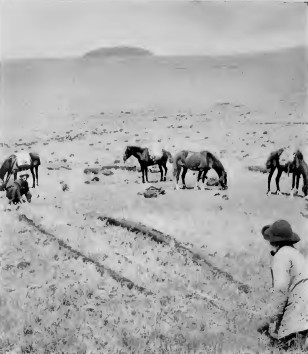 FIG. 84. — STONE FOUNDATIONS. 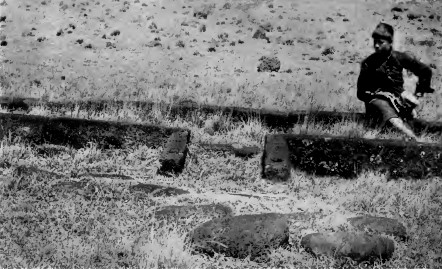 FIG. 84A. —ENTRANCE AND PAVED AREA. Housing
accommodation presented no great problem. Many slept in the open, and
even
to-day, in the era of Christianity and European clothes, a cave is
looked upon
as sufficient shelter. When on moving from our "town" to our
"country" house we inquired where our attendants were to sleep, we
were cheerfully informed "it was all right, there was a very good cave
near Tongariki" — and this cave, called Ana Havea, became a permanent
annexe to the establishment (fig. 124). Some of these caves had a wall
built in
front for shelter. Houses,
however, did exist, which were built in the form of a long upturned
canoe; they
were made of sticks, the tops of which were tied together, the whole
being
thatched successively with reeds, grass, and sugar-cane. In the best of
these
houses, the foundations, which are equivalent to the gunwale of the
boat, are
made of wrought stones let into the ground; they resemble the
curbstones of a
street pavement save that the length is greater. In the top of the
stones were
holes from which sprang the curved rods, which were equivalent to the
ribs of a
boat, and formed the walls and roof (figs. 84 and 85) . The end stones
of the
house are carefully worked on the curve, and it is very rare to find
them still
in place, as they were comparatively light, weighing from one to two
hundredweight, and easily carried off. Even the heavier stones were at
times
seized upon as booty in enemy raids; one measuring 15 feet was pointed
out to
us near an ahu on the south coast, which had been brought all the way
from the
north side of the island. In the middle of one side of the house was a
doorway,
and in the front of it a porch, which had also stone foundations. The
whole
space in front of the house was neatly paved with water-worn boulders,
in the
same manner as the ahu. This served as a stoop on which to sit and
talk, but
its practical utility was obvious to ourselves in the rainy seasons,
when the
entrance to our tents and houses became deep in mud (fig. 84A). Near
the main
abode was a thatched house which contained the native oven, the stones
of which
are often still in place. The cooking was done Polynesian fashion: a
hole about
15 inches deep is lined with fiat stones, a fire is made within, and,
when the
stones are sufficiently heated, the food, wrapped up in parcels, is
stacked
within and covered with earth, a fire being lighted on the top. Many of
the surviving old people were born and brought up in these houses,
which are
known as "haré paenga." The old man, for example, before alluded to,
who was brought out to Raraku, roved round the mountain telling with
excitement
who occupied the different houses in the days of his youth. He gave a
particularly graphic description of the scene after sundown, when all
were
gathered within for the evening meal. In addition to the main door,
there was,
he said, an opening near each end by which the food was passed in and
then from
hand to hand; as perfect darkness reigned, a sharp watch had to be kept
that it
all reached its proper owners. He lay down within the old foundations
to show
how the inhabitants slept. This was parallel to the long axis of the
house, the
head being towards the door; the old people were in the centre in
couples, and
the younger ones in the ends. The largest of these houses, which had
some
unique features, measured 122 feet in length, with an extreme width of
12 feet;
but some 50 feet by 5 feet or 6 feet are more usual measurements. They
were
often shared by related families and held anything from ten to thirty,
or even
more, persons. 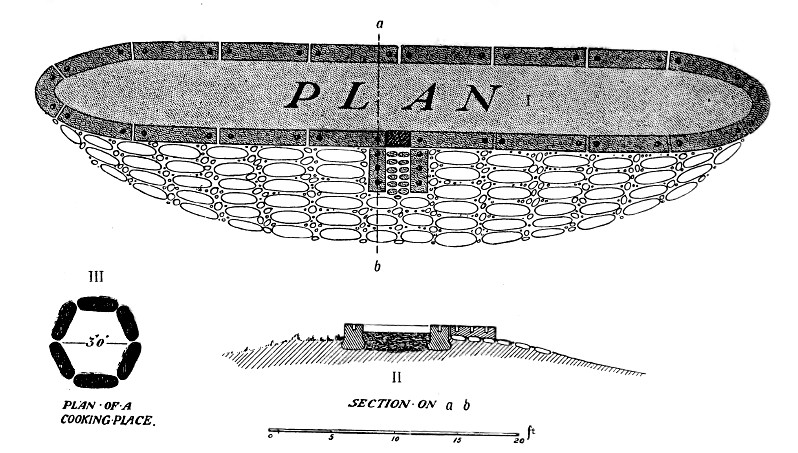 FIG. 85. — CANOE-SHAPED HOUSE. Diagram of stone foundations, paved area and cooking-place. The food
consisted of the usual tropical produce, such as potatoes, bananas,
sugar-cane,
and taro. Animal diet formed a very small part of it, rats being the
only form
of mammal; but chickens played an important role in native life, and
the
remains of the dwellings made for them are much more imposing than
those for
human beings. They are solid cairns, in the centre of which was a
chamber,
running the greater part of their length; it was entered from outside
by two or
more narrow tunnels, down which the chickens could pass. They were
placed here
at night for the sake of safety, as it was impossible to remove the
stones in
the dark without making a noise (fig. 86). Fish are not very plentiful,
as
there is no barrier reef, but they also were an article of diet, and
were
bartered by those on the coast for the vegetable products obtained by
those
further inland. Fish hooks made of stone were formerly used, and a
legend tells
of a man who had marvellous success because he used one made of human
bone. The
heroes of the tales are also spoken of as fishing with nets. There are
in
various places on the coast round towers, built of stone, which are
said to
have been look-out towers whence watchers on land communicated the
whereabouts of
the fish to those at sea; these contained a small chamber below which
was used
as a sleeping apartment (fig. 87). Turtles appear on the carvings on
the rock,
and are alluded to in legend, and turtle-shell ornaments were worn; but
the
water is too cold for them ever to have been common, and Anakena is
almost the
only sandy bay where they could have come on shore. The sole form of dress was the cloth made from the paper mulberry, and known throughout the South Seas as tapa; it was used for loin-cloths and wraps, which the Spaniards describe as fastening over one shoulder. Head-gear was a very important point, as witnessed by the way the islanders always stole the caps of the various European sailors. The natives had various forms of crowns made of feathers, some of them reserved for special occasions. Cherished feathers, particularly those of white cocks, were brought out of gourds, where they had been carefully kept, to manufacture specimens for the Expedition. The crowns are generally made to form a shade over the eyes, like the head-dresses of the images. Naturally, every effort was made to find the prototype of the image hats. No one recollected ever seeing anything precisely like it, but among the pictures drawn for us of various head-decorations was a cylindrical hat made of grass; the brim projected all the way round as with a European hat, but it had the same form of knot on the top as that of the statues. 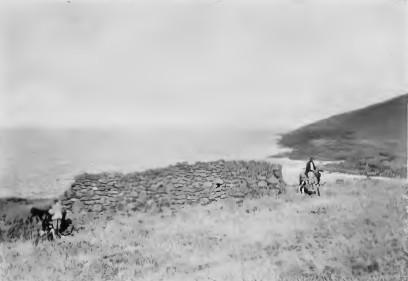 FIG. 86. — HOUSE FOR. CHICKENS. 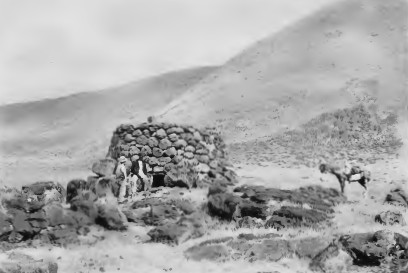 FIG. 87. — A TOWER USED BY FISHERMEN. Tattooing
was a universal practice, and the exactness of the designs excited the
admiration of the early voyagers, who wondered how savages managed to
achieve
such regularity and 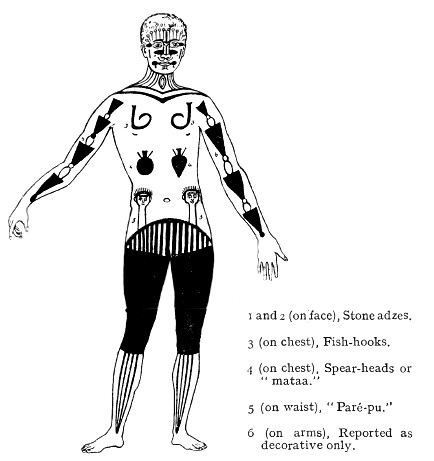 FIG. 88. — DESIGNS USED IN TATTOOING, DRAWN BY NATIVES. accuracy.
The drawings made for us from the descriptions of the old people show
the men
covered, not only with geometrical designs, but with pictures of
every-day
objects, such as chisels and fish-hooks; even houses, boats, and
chickens were
represented in this way according to taste. The most striking objects
were
drawings of heads, one on each side of the body, known as "pare-pu,"
which the old mariners describe as "fearsome monstrosities"18
(fig. 88). Various old persons said that they remembered seeing men
with a
pattern on the back similar to the rings and girdle of the images. It
seems,
however, doubtful whether the image design merely represented tattoo,
in view
of the fact that it was raised, not incised, and in any case this would
only
put the search for its prototype a stage further back. The fact,
however,
remains that those particular marks were still being perpetuated, and
form a
link connecting the present with the past. Beechey, in 1825, tells us
the women
were so tattooed as to look as if they wore breeches. In addition to
this kind
of decoration, the islanders adorned themselves with various colours:
white and
red were obtained from mineral products found in certain places; yellow
from a
plant known as "pua,"19 and black from ashes of
sugar-cane. They had a distinct feeling for art. Some of the paintings
found in
caves and houses are obviously recent, and it is a frequent answer to
questions
as to the why and wherefore of things, that they were to make some
object
"look nice."
It will
be remembered that not only have the images long ears, but that all the
early
voyagers speak of them as general among the inhabitants. It was
therefore
somewhat surprising to find that no such thing was known as a man whose
ears
had been perforated, though with the women the custom went on till the
introduction of Christianity, and two or three females with the lobe
dilated in
this manner still survived (fig. 90). At last one old leper recalled
that the
father of his foster-father had long ears, and on asking as a child for
the
reason, he had received the illuminating reply that "the old people had
them like that." He also mentioned one or two others with similar ears,
and this was subsequently confirmed by other authorities. It will be
seen that
the custom, as far as men were concerned, of dilating the lobe of the
ear, must
have been abandoned at the end of the eighteenth century, or just about
the
time of the visits of the Spanish, English, and French Expeditions.
That this
was cause and effect, and that they imitated the appearance of the
foreign
sailors, seems more than a guess; it will appear from other sources how
great
was the impression which was made by the foreigners. Social
Life.
—
Roggeveen's description of the people as being of all shades of colour
is still
accurate. They themselves are very conscious of the variations, and
when we
were collecting genealogies, they were quite ready to give the colour
of even
remote relations: "Great-aunt Susan," it would be unhesitatingly
stated, was "white," and "Great-aunt Jemima black." The
last real ariki, or chief, was said to be quite white. “White like me?”
I
innocently asked. “You!” they said, “you are red"; the colour in
European
cheeks, as opposed to the sallow white to which they are accustomed, is
to the
native our most distinguishing mark. It is obvious that we are dealing
with a
mixed race, but this only takes us part of the way, as the mixture may
have
taken place either before or after they reached the island. They were
divided into ten groups, or clans ("máta"), which were associated
with different parts of the island, though the boundaries blend and
overlap;
members of one division settled not infrequently among those of
another. Each
person still knows his own clan. In
remembered times there were no group restrictions on marriage, which
took place
indiscriminately between members of the same or of different clans. The
only
prohibition had reference to consanguinity, and forbade all union
nearer than
the eighth degree or third cousins. These ten clans were again grouped,
more
especially in legend or speaking of the remote past, into two major
divisions
known as Kotuu (or Otuu), and Hotu Iti, which correspond roughly with
the
western and eastern parts of the island. These divisions were also
known
respectively as Mata-nui,
or greater clans, and Mata-iti, or lesser clans. The lower portions of
the
island were the most densely populated parts, especially those on the
coast,
and the settlements on the higher ground appear to have been few (fig.
91). In Kotuu,
the Marama and Haumoana inhabited side by side the land running from
sea to sea
between the high central ground and the western volcano Rano Kao. They
had a
small neighbour, the Ngatimo, to the south, and jointly with the Miru
spread
over Rano Kao and formed settlements by the margin of the crater lake.
The Miru
lived on the high, narrow strip between the mountain in the apex and
the cliff,
and mixed up with them was a lesser people, the Hamea. To the east was
another
small clan, the Raa, which is spoken of in conjunction with the Miru
and Hamea. The
principal Hotu Iti clans were the Tupahotu, the Koroorongo, and the
Hitiuira.
The last were generally known as the "Ureohei"; they inhabited
jointly the level piece of ground from the northern bay to the south
coast, and
had some dwellings on the eastern headland. Next to them on the south
coast was
a small group, the Ngaure.20 The particular
importance of the clans
lies in the fact that, while they may be merely groups of one body,
they may,
on the other hand, represent different races or waves of immigrants. If
there
have been two peoples on Easter Island, these divisions are one place
where we
must at least look for traces for it. Legend
tells of continual wars between Hotu Iti and Kotuu. In recent times
general
fighting seems to have been constant, and took place even between
members of
one clan. A wooden sword, or paoa, was used, but the chief weapon was
made from
obsidian, and took from it the name of "mataa." This volcanic glass
is found on the slope of Rano Kao, but the principal quarries are on
the
neighbouring hill of Orito. Tradition says its use was first discovered
by a
boy who stepped on it and cut his foot. The obsidian was knapped till
it had a
cutting edge, and also a tongue, which latter was fitted into a handle
or stick
(fig. 92). The various shapes assumed were dignified by names, fourteen
of
which were given, such as "tail of a fish," "backbone of a
rat," "leaf of a banana." It was very usual to pick up these
mataa, and hoards were occasionally found; in one instance fifty or
sixty were
discovered below a stone in a cave, and in another case the
hammer-stone was
found with them which had been used in the process of squeezing off the
flakes.
The weapon was used both as a spear and as a javelin. A site is pointed
out
near Anakena, where a man throwing down hill killed another at about
thirty-five yards. The art of making these mataa is, of course,
practically
extinct, but one old man, commonly known as "He" (fig. 83), brought
us some which he had manufactured himself for the Expedition, and which
were
fairly well wrought. With the
exception of the Miru, of which more will be said, there were no chiefs
nor any
form of government; any man who was expert in war became a leader. The
warfare
consisted largely of spasmodic and isolated raids; an aggrieved person
gathered
together his neighbours and descended on the offenders. It is related
incidentally that one man, going along the south coast, “found war
going
on," one set of men having blocked up another in a cave. Another story
is
told of six men, called Gwaruti-mata-keva, of the clan Tupahotu, who
lived in a
cave in a certain hillock on the south coast, known as Toa-toa. They
went round
in a boat to Hanga Piko, stole fish, and returned rapidly to their
cave. A
hundred men from Hanga Piko then came overland to punish the robbery,
and made a
fire of grass before the cave in which the men lay hidden. When the
attackers
assumed that the enemy were all dead from suffocation, they went into
the cave;
but those within had buried their faces in holes scraped in the earth,
and when
the men from Hanga Piko entered, they arose and slew the whole hundred.
A more
interesting fact came out incidentally in connection with this gang of
Toa-toa,
connecting them with the secret societies found elsewhere in the
Pacific. They
were, it was said, in the habit of going about after dark with their
faces
painted red, white, and black, and visiting houses, where they declared
they
were gods, and demanded food, which the inhabitants accordingly gave
them. The
fraud, however, finally came to light when one day a man, who was
travelling
with his servant, saw them washing paint off their faces, “so they knew
that
they had deceived the people, and the people gathered together and
killed
them." In these
internecine fights fire was very generally set to the enemy's
dwellings. “He
often burnt houses," a young man said, pointing to an older one, and
the
impeachment was not denied. The ahu, too, were raided and bodies burnt,
which
seems to be the cause of the burnt bones recorded by certain
travellers; there
is no reason to suppose there was cremation or sacrifice on Easter
Island. It
was in this sort of warfare that the last images were overthrown. 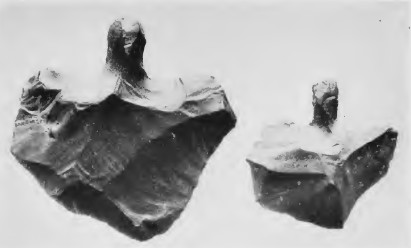 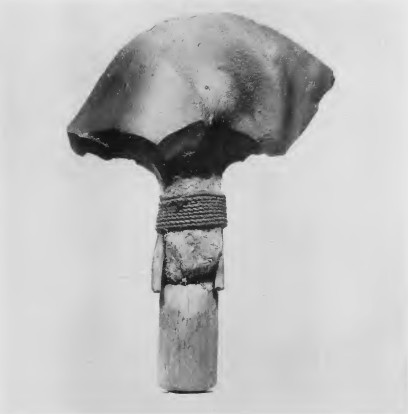 [Brit. Mus.] FIG. 92. OBSIDIAN SPEAR-HEADS. (Mataa.) While
legends record how many people were eaten after each affray, all living
persons
deny, with rather striking unanimity, not only that they themselves
have ever
been cannibals, but that their fathers were so. If this is correct, the
custom
was dying out for some reason before the advent of Christianity;21
their
grandfathers, the old people admit, ate human flesh, but, if there were
any rites
connected with it, they "did not tell." The great-grandmother of an
old man of the Miru clan was, according to his account, killed on the
high
central part of the island by the Ureohei and eaten. In revenge for the
outrage, one of her sons, Hotu by name, killed sixty of the Ureohei.
Another
son, who had pacifist leanings, thought the feud ought then to be
ended, but
Hotu desired yet more victims, and there was a violent quarrel between
the two
brothers, in which the peace-maker was struck on the head with a club;
for, as
Hotu remarked, if they had slain his father, it would have been
different, but
really to eat his mother was "no good." Our
acquaintance with the person said to have been "the last cannibal,"
or rather with his remains, came about accidentally during the time
when I was
alone on the island. A little party of us had ridden to the top of the
volcano
Rano Kao; and on the southern side of the crater, that opposite Orongo,
some of
the natives were pointing out the legendary sites connected with the
death of
the first immigrant chief, Hotu-matua. Suddenly one of them vanished
into a
crevice in the rocks, and reappeared brandishing a thigh-bone to call
attention
to its large size. I dismounted, scrambled into a little grotto, or
natural
cave, where a skeleton was extended; the skull was missing, but the
jaw-bone
was present, and the rest of the bones were in regular order; the
individual
had either died there or been buried. Bones were in the department of
the
absent member of the Expedition, but it was of course essential to
collect
them, from the view of determining race, and the natives never resented
our
doing so. I therefore passed these out, packed them in grass in the
luncheon-basket,
and, sitting down on a rock, asked to be told the story of the cave.
“That,"
my attendants replied, “is Ko Tori." He was, they said, the last man on
the island who had eaten human flesh. In this hiding-place he had
enjoyed his
meals, and no one had ever been able to track him. There had formerly
been a
cooking-place, but it was now hidden by a fall of stones. He had died
as a very
old man at the other end of the island, apparently in the odour of
sanctity; to
judge by the toothless jaw if he had not deserted his sins they must
long ago
have deserted him. His last desire was to be buried in the place with
which he
had such pleasant connections, and in dutiful regard to his wishes, or
because
it was feared that his ghost might otherwise make itself unpleasant,
some of
the young men bore the corpse on stretchers along the south coast and
up to the
top of the mountain, depositing it here. The next thing was to get at
some sort
of date; chronology is naturally of a vague order, and the most
effective method
is, if possible, to connect events with the generation in which they
happened.
"Did your grandfather know him," was asked, "or your father?” The
answer was unexpected. “Porotu," they said, pointing to one of the old
men,
“helped to carry him," and silence fell on the group. My heart sank; I
had
then undone this last pious work and committed sacrilege. To my great
relief,
however, strange sounds soon made it clear that the humorous side had
appealed
to the escort; they were suffocating with mirth. "And now," they
said, gasping between sobs of laughter, “Ko Tori goes in a basket to
England." As I write, Ko Tori resides at the Royal College of Surgeons,
and has done his bit towards elucidating the mystery of Easter Island. Sexual
morality, as known to us, was not a strong point in life on the island,
but
marriage was distinctly recognised, and the absolute loose liver was a
person
apart. Polygamy was usual, but many seem to have had only one wife. The
children belonged to the father's clan, and are often distinguished by
his name
being given after their own. At the same time the clan of the mother
was not
ignored, and a man would sometimes fight for his maternal side. If a
man had
sons by more than one wife,, after his death each claimed the body of
his father
to lie on the ahu of his mother's clan, and the corpse might thus be
carried to
several in turn, finally returning to its own destination. We collected
a
certain number of genealogical trees, the various dramatis
personæ being for this purpose represented by matches or
buttons. It was not a very popular line of research, the cry being apt
to be
raised, “Now let's talk of something interesting"; but some two hundred
names were in this way placed in their family groups, with details of
clan,
place of residence and colour, and some knowledge obtained with regard
to many
more. It is not of course enough ground on which to found any theory,
but it
was very useful in checking information gathered in other ways. Only in
one
case was it possible to get back beyond the great-grandfather of our
informant,
but the knowledge of family connections was often greater than would be
found
among Europeans. The number of childless marriages was striking. The early
story of Viriamo (fig. 83), the oldest woman living in our day, gives a
picture
of this primitive state of things. She belonged to the clan of Ureohei,
and her
family had lived for some generations, as far back as could be
remembered, on
the edge of the eastern volcano, not far from Raraku. The
great-grandfather,
who was dark, had as his only wife a white woman of the Hamea. Their
son was
white, and had two wives, one of the Tupahotu and one of the Ngaure. By
the
first, although she also was white, he had a dark son who married a
white wife
of his own clan, Ureohei, but of a different group. Viriamo was the
second of
their eight children, all of whom were white save herself and her
eldest
brother. Four of the girls died young in the epidemic of smallpox in
1864.
Viriamo and two of her sisters were initiated as children into the bird
rite.22
When older she was tattooed with rings round her forehead and with the
dark-blue breeches. Somewhat later, but still as a young woman, she
went over
to Anakena and had her ears pierced, but she never had the lobe
extended, preferring
to let it remain small. When asked about her marriage, she bridled as
coyly as
a young girl. Her first union was a matter of arrangement, the husband,
who was
also of the Ureohei, giving her father much food, and, if she had
refused to
accept the situation, she would, she said, have been beaten. There was
no
ceremony of any kind, no new clothes nor feasting; her father simply
took her
to her new home and handed her over. The house was near the two statues
with
the projecting noses, excavated on the south-eastern slope of Raraku
(fig. 73),
and, when she wanted water, rather than cross the boundary and go round
to the
lake by the gap, through the hostile dwellers on the western side, she
used to
clamber with her vessel up the boundary rift in the cliff face. There
was one white
child, who died young, but her marriage was not a success, and Viriamo
left the
man and went off to live with one of the Miru clan at Anakena. His
house
already contained a wife and family, also four brothers, but they all
got on quite
happily together. She had five children by this man, who, like their
father,
were all white; four of them, however, died in infancy. This was the
result of
the parents having most unfortunately fallen foul of an old man, whose
cloak
had been taken without his consent, and who had accordingly prophesied
disaster. The remaining child, a daughter, was living and unmarried
when we
were on the island. The last husband was the most satisfactory of the
three; he
was a Tupahotu living near Tongariki. She was handed over to him as a
matter of
family arrangement, in discharge of a debt, but she was quite amenable
to the
exchange, and was very fond of him. He was light in colour, but her
only child
by this marriage, our friend Juan, was dark, taking, as he said, “after
my
mam-ma." The women
do not seem, judging by existing remains, to have had always a happy
time. Dr.
Keith, who examined the skulls collected by the Expedition, concludes
his
report on one of the female specimens as follows: "The most likely
explanation
is that the indent of the left temple was the cause of death, produced
by the
blow of a club, and that the suppuration and repair of the right side
has been
also produced by a former blow which failed to prove fatal. Two other
skulls,
also those of women, show indented fractures in the left temporal
region." Any
deficiency at marriages, in the way of social festivity, was made up at
funerals. These were attended by persons from all over the island, for
"when
they were not fighting, they were all cousins." In answer to the remark
that "considering the population their whole time must have gone in
this
way," it was cheerfully observed that "they had nothing else to do,
so they all went, everybody took food and everybody ate." The parents
of
one of our friends, Kapiera, lived at Anakena, but he was born on the
south side
of the island near Vaihu "when his mother went for a funeral." The
men who knew the tablets went also and sang, but there seems to have
been
little or nothing in the way of rites. The missionaries were impressed
with the
fact that there was no ceremony of any kind at a burial. Most
elaborate spells were, however, performed in connection with a man who
had been
slain, known as "tangata ika," or fish-man; the corpse was kept from
resting either day or night while his neighbours went in pursuit of
vengeance.
In front of one ahu, on the north coast, some pieces of the old statues
have
been formed into a rude chair. On this, it was said, had been seated
the naked
body of a man belonging to the district, Kotavari-vari by name, who had
been
killed at Akahanga on the south coast. One man kept the corpse from
falling,
while two others sat behind and chanted songs to aid the avengers.
These
watchers were covered with black ashes, wore only feather hats, and
carried the
small dancing-paddle known as "rapa" (fig. 116); the chief man in
charge of the ceremony was known as the "timo." It must have been an
eerie scene as dusk came on. The story is told of a murder near
Tongariki. In
this case the victim's corpse was placed on the ahu and turned over at
intervals by the watchers. Hanga Maihiko, a converted image ahu on the
south
coast, is one of those which have a paved approach, and there are on
the
pavement two stones — pieces of a hat and a statue — specially used for
exposing "fish-men" (fig. 93). If these charms failed to act, there
was a still more reliable way. The clothes of the victim were buried
beneath
the cooking-place of the foe, and when he had partaken of food prepared
there
he would certainly die the night following. Some of the carved tablets
were
connected with these rites; one was certainly known as that of the
"Ika,"
while there is said to have been another called "Timo," which was the
"list" kept by each ahu of its murdered men. 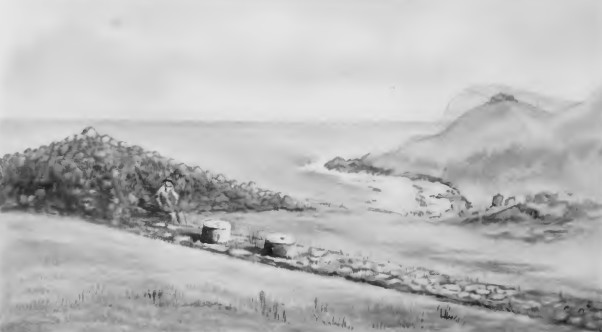 FIG. 93. — AHU, HANGA MAIHIKO Old Image, Ahu, converted to semi-pyramid form, with paved approach; also two stones on which were exposed the corpse of slain men. The
custom of exposing the dead was, as has been stated, going on in living
memory.
The information already given on this head is confirmed by the accounts
of the
missionaries,23 but burial was also practised,
the mode of disposal
being a matter of choice. There were two drawbacks to exposure:
firstly, if the
deceased was for any reason an uncanny person, his ghost might make
itself
unpleasant — he was safer hidden under stones; secondly, the body, if
left in
the open, might be burnt by enemies; this latter was the reason given
for the
burial of the last great chief, Ngaara, who was interred in one of the
image
ahu on the western coast. Not only were the ruins of the greater ahu
still
being used, but up till 1863 smaller ones were being built. One was
pointed out
on the north coast as having been put up for an individual, the
maternal aunt
of our guide, the lady having had the misfortune to be killed by a
devil in the
night. It was a small structure, ovoidal in shape, 10 feet in length,
with a
fiat top sloping from a height of 9 feet at the end towards the sea, to
4 feet
6 inches at that towards the land; there was beneath it a vaulted
chamber for
bones. 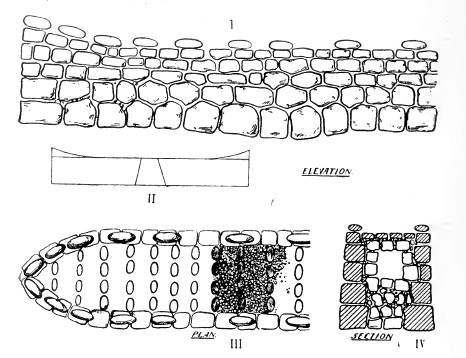 FIG. 94. DIAGRAM OF AHU POE-POE (CANOE-SHAPE). Burial
cairns, called "ahu poe-poe," were being made in modern times, and a
man skilled in their construction was amongst those who were carried
off to Peru.
The word "poe-poe" is described as meaning a big canoe, such as their
ancestors came in to the island. It is applied to two types of ahu, one
of
which is obviously built to resemble a boat; of this kind there are
about
twelve in the island. One large one (fig. 94) measured as much as 178
feet in
length, the width being 20 feet, while the ends, which are made like
the bow
and stern of a canoe, are about 10 feet to 15 feet in height. The flat
top is
paved with sea-boulders, and is surrounded by a row of the same in
imitation of
the gunwale of a boat. In one such ahu two vaults were found by us just
below
the surface with perfect burials. One was the body of an old man, the
other of
a woman with a child. Both had been wrapped in reeds, and with the body
of the
woman were some glass beads. On the surface of the ahu were a few
bones,
possibly of a body which had been exposed there, but the ahu had
apparently
been built for the two interments. It is less obvious why the same
name, “ahu
poe-poe," should be applied to a burial-place which was wedge-shaped in
form. It follows the lines of the image ahu in so far as having a wall
towards
the sea flanked on the land sides by a slope of masonry. It might be
held to
represent the prow of a boat, but resembles rather a pier or jetty.
Only some
six of these were seen, of which the longest was 70 feet. One in a
lonely spot,
at the very edge of a high cliff, which overlooked Anakena Bay, formed
a most
striking abode for the dead (fig. 95). In a few
cases the term ahu is given to a pavement, generally by the roadside,
neatly
made of rounded boulders and edged with a curb; the form was said to be
ancient. One of those on the west road was reported as specially
dedicated to
mata-toa — which signifies victors or warriors — and the same was said
of a
differently made ahu on the south coast .24 Neither
exposure nor interment was necessarily confined to ahu, and corpses
were
frequently disposed of in caverns, as in the case of Ko Tori. Three
instances
were mentioned, an uncle and two nephews, where the corpses, after
being
exposed, were lowered with a rope down the crevasses of the cliff of
Raraku in
order to evade the enemy. One of the nephews, who had been of the party
when
the final statues were overthrown, had met with a tragic end, being
drowned by
catching his hand in a rock when diving for lobsters under water. With
the
exception of those near the standing statues, we practically never
found an
earth burial. This seems to account for the exaggerated estimates of
the number
of human remains on the island; it is doubtful if even five hundred
skulls
could be collected, but, whether in caves or ruined ahu, a large
proportion of
those which exist are very much in evidence. Memorials
of the dead were erected in various places independently of the actual
locality
where the corpse rested. Some of these were simply mounds of earth,
which can
be seen on various hills; there is a regular succession on the landward
rim of
the Raraku crater, opposite to the great cliff, but one at least of
these was a
memorial to a man whose body had been disposed of in the clefts of the
cliff.
Others of these independent memorials were in the shape of cairns about
6 feet
in height, known as "pipi-hereko," and were formerly surmounted by a
white stone. Many of them still exist, and they are particularly
numerous on
the high ground above Anakena Cove. The locality was chosen as one
which was
but little inhabited, for the taboo for the dead (or pera) extended to
them,
and no one went near them in the daylight, on penalty of being stoned,
till the
period of mourning had been terminated with the usual feast. Various
voyagers
commented on these cairns, which were marked objects, and Cook thinks
that they
may have been put up instead of statues. It would
seem by the following tale, which imposes a somewhat severe strain on
the
European imagination, that piles of stones had in the native mind a
certain
resemblance to the human figure. “There was once an old lady who had an
arm so
long that it could have reached right across the island. She was a bad
old
woman, and once a month had a child to eat, so a certain man determined
to put
an end to her power for doing harm. He took her out in a boat to fish,
first
telling his small son to collect stones, and after they had gone to put
them in
piles in front of the house of the woman, and also to make a fire and
much
smoke. When the canoe had got out to sea, he looked back and found the
boy had
done as he was told, and glimpses of the cairns could be seen among the
clouds
of smoke. Then he called to the old woman, 'Look, there are men at your
house!'
So she put out her long arm to seize what she thought were the people
going to
rob her hut, whereon the man seized the paddle and brought it down on
her arm
and broke it; then he killed the old woman and threw her body into the
sea. Life was
by no means dull in Easter Island, for if a feast was not being given
to
commemorate a departed relation, it was arranged in honour of one
whilst still
alive. The "PAINA," which means simply picture or representation, was
given by the family as a testimonial of esteem to a father, or possibly
a
brother who might be either alive or dead; it was a serious matter, and
the
original direction for the celebration came from a supernaturally
gifted individual
known as an "ivi-atua." The paina was a large figure made of woven
rods, and the host would clamber up inside it and look through eyes or
mouth;
it had a crown made of the wings of a particular sea-bird, known as
"makohe,"
and long ears. Occasionally it was put up on a special spot, where, for
example, a man had been killed, but the interesting point in connection
with
the paina is that the usual place for erection was in front of an image
ahu on
its landward side, and at most, or all, of the large ahu, there can
still be
seen, in the grass at the foot of the paved slope, the holes where the
paina
have stood. It was kept in place by four long ropes, one of which
passed over
the ahu. The feast was held in the summer, and lasted from two to four
days; at
any given ahu there might be only one in the season or as many as five.
The
drawbacks, which would have seemed obvious to such a locality, do not
seem to
have clouded the entertainment; the feasting was great, and consisted
largely
of rats which were caught in the hen-houses. The recollection of these
entertainments and the crowds who attended them were very vivid, and
Viriamo's
eyes brightened as she told of the singing, dancing, and feasting of
her youth. 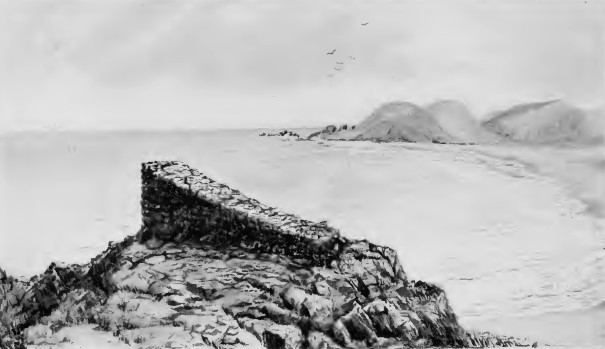 FIG. 95 — AHU POE-POE (WEDGE SHAPE). There are
records of another figure which appears to have been different from the
paina;
it was clothed and known as "KO PEKA." The Spanish Expedition in 1770
says that the islanders brought down to the beach, on the day when the
three
crosses were set up, an idol about 11 feet high like a "Judas,"
stuffed with straw; it was all white, and had a fringe of black hair
hanging
down its back. They put it up on stones and sat cross-legged around it,
howling
all night by the light of flares. As no information was volunteered to
us about
such celebrations, the natives were asked if they had ever known a
similar
figure, and an old man at once replied that there had existed one just
like the
description, made of reeds, as a memorial of a dead wife or "fine"
child; it stood in front of the house, or was sometimes carried to a
hillock
where the people assembled to mourn. One of the officers of the La
Pérouse Expedition
also described a figure seen near a platform; it was 11 feet in height,
clothed
in white tapa ("étoffe blanche du
pays"); it had hanging round the neck a basket covered with
white, and
by the side of this bag the figure of a child 2 feet long. This seems
to
confirm the information that it was intended to represent a woman. Another
great festivity, given for a father either living or dead, was the
''KORO."
This was a house-party on a very extended scale. A special dwelling
made with
poles and thatched was put up, and, according to accounts, which
surround it no
doubt with a halo from the past, measured some hundreds of feet in
length and
20 feet in height. An old man stated that at a celebration at which he
was
present there were "a hundred guests," a number which is probably a
guess, but the addition that there were "ten cooking-places" sounds
like memory. Invitations to these festivities were much in request, as
there
was "no work to do"; presents of food were brought to the hero who
distributed them to the party. They seem to have lasted indefinitely,
going on
for months, and the time was passed with various entertainments. The
old people
sang, the young people danced, and the host, who lived in a little
house near,
came and looked on. On the last day there was a great feast, and the
house was
broken down with the aid of the carved wooden lizards, which are
associated
with the island (fig. 117). We were puzzled in coming across a rough
stone
building, near Anakena, which seemed to be neither ahu, dwelling, nor
chicken-house; it had been, the men told us, a shelter for the posts of
the
koro, where they were kept in readiness for the next celebration. There was
yet another entertainment which is said to have been in honour of a
mother, as
a koro was of a father. In at least four different places on the island
are to
be seen a dancing-ground known as "KAUNGA." It is a narrow strip
paved with pebbles, over 200 feet in length by 2 feet in width, and not
unlike
the paved approach to some of the ahu. A demonstration was given of the
way it
was used. The dancers, “fine men, fine women," as was explained with
emphasis, proceeding along it single file, holding rapa in both hands.
In
connection with some or all of the kaunga there was a house where the
party
remained indoors for a long time previous to the dances, in order to
"get
their complexions good," a touch which shows that a white skin was
admired. These
feasts were held in certain months only, determined by the appearance
of the
heavens after nightfall. On the extremity of the eastern headland there
is an
outcrop of boulders, one of which is incised with a spiral design; the
place is
known as "Ko Te Papa-ui-hetuu," or, “The Rock-for-seeing-stars,"
and here the old men came to watch the constellations. About two
hundred yards
from these boulders there is another engraved stone on which ten
cup-shaped
depressions are visible; this represented, it is said, “a map of the
stars." The
season for the Paina depended on the position of the three central
stars of
Orion, with regard to which the following story is related. A certain
married
woman, on going down to bathe, was carried off by a stranger. When her
husband
discovered this, he slew her in his anger, and she fled up to be a
star. The
husband then took their two boys, one in each hand, and followed her to
the
sky, where the three form the belt of Orion. The wife, however, would
have
nothing to do with them, and remained in a separate part of the
heavens. This
is the only nature myth which we encountered on the island. 1 An
island was reported in lat. 27° by an English buccaneer named Davis in
1687. It
was, he said, five hundred miles from the coast of Chile, low and
sandy, and
some twelve leagues to the west of it was seen "a long tract of pretty
high land." The description in no way applies to Easter, with which it
has
sometimes been identified. The probability seems to be that Davis was
out of
his reckoning, as was by no means unusual in the case of the early
mariners,
and it has been suggested that the island he saw was Crescent Island,
the high
ground in the distance being the Gambier group. The latitude of Easter
Island
is 27° 8' S., that of Crescent Island is 23° 20' S. 2
Precisely the same habit obtains to-day among the Akikuyu in East
Africa. 3 For
Roggeveen's description of the Island see Voyage
of Gonzalez. Hakluyt Society,
Series II., vol. xiii., pp. 3 to 26. A
statement of the evidence re Davis Island is given in the introduction
to the
same volume. 4 Voyage
of Gonzalez, p. 27 seq. 5 A
Voyage Towards the South Pole and Round
the World, by James Cook, 1st ed., 4to, 1777, pp. 276-96. A
Voyage Round the World,
George
Forster, 410, 1777. Vol. i., pp. 551602. 6 Voyage de La
Pirouse autour du Monde. 4to
edn.,
London, 1799. Vol. i., pp. 319-36. 7 MS. copy
in the British Museum of a letter sent by one of the officers of the
Spanish
ship to a Canon or a Prebendary in Buenos Aires. MSS. 17607 (18). Our
attention
was drawn to this document by Dr. Corney. 8 See
above, p. 171. 9 Voyage
of Gonzalez, p. 126. 10 Voyage
Round the World in the Ship
“Neva," Lisiansky, Lond. 1 8 14, p . 58. 11 Voyage
to the Pacific, H.M.S.
"Blossom," p. 41. 12 See Annales de
la Propagation de la Foi.
1866, 1867, 1869. 13 Journal
Ethnological Society, Vol. i. p.
373. 14 The
above statement is made on the authority of Mr. John Brander of Tahiti.
According to report of H.M.S. Sappho,
which visited the island in 1882, Salmon was then an agent of the
Maison
Brander. 15 Smithsonian
Report, 1889. 16 In the Odyssey
Athene speaks of Odysseus as
"in a sea-girt isle, where is the navel of the sea." {Odyssey,
Bk. I., 1. 50, Butcher &
Lang.) 17 Easter
Island. The Rapa-nui Speech. W.
Churchill, p. 3. 18 Voyage
of Gonzalez,
p. 90. 19 One of
the Scitamineæ — further determination awaits the blooming of plants
brought
back to Kew. 20 Of these
clan names, “Raa" means the sun and "Marama" the light. The
signification of the others is not equally clear, and the natives could
give no
assistance; but Mr. Ray gives the following interesting information
from other
Polynesian sources. “Haumoana" means the sea-breeze; "Hitiuira"
is probably "hiti-ra" or sunrise; and "Ure-o-hei" another
version of "ura-o-hehe," or red of sundown, “Koro-orongo" is
doubtless from "Koro-o-Rongo," or the ring of Rongo (a well-known
Polynesian deity), that is the rainbow. “Kotuu" appears to be a
contraction of "Ko Otuu," meaning "The Hill"; the name
"Otuu" is used alternatively for the same district. “Hotu" is
another form of the word for hill and "Iti" signifies small, it
presumably refers to Rano Raraku. 21 Since
writing the above the following has been seen: "The higher Polynesian
races, such as the Tahitians, Hawaiians, Samoans, had one and all
outgrown, and
some of them had in part forgot, the practice (cannibalism) before Cook
or
Bougainville had shown a topsail in their waters." — In
the South Seas, R. L. Stevenson, p. 94. 22 See
Chapter XVI; the section on the Bird Cult. 23
"These bodies, enveloped in mats, are placed on a heap of stones or on
a
kind of wooden structure, the head being turned towards the sea. Now,
as all
the population live round the island, dried skeletons are to be met all
along
this coast, and no one seems to take any notice of them." — Letter from
Brother Eyraud — Annals of the
Propagation of the Faith, Jan. 1866. 24 When all
those ahu which can be placed in categories as Image, Semi-Pyramid,
Canoe, Wedge-shaped,
or Pavement have been noted, there remain, out of the total of two
hundred and
sixty burial-places, some fourteen which are unique in design; and
between
sixty and seventy which cannot be classified, either because they are
mere
cairns or in too ruined a condition to be identified. |
